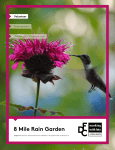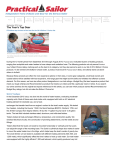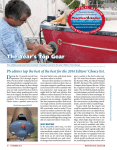Download Wiley Digital Landscape and Nature Photography For Dummies
Transcript
Index CO PY RI RI TE MA D GH TE accessories batteries, 51 camera bag, 44–46 camera strap, 49–50 for cleaning camera, 50 filters, 46–47 for Lensbaby, 204 lens-cleaning brush, 51 lens-cleaning cloth, 51 memory card holder, 51 memory cards, 51 protecting camera from weather, 49 for shooting video fluid ball head, 71 LCD monitor hood, 71 Steadicam, 70 tripod, 71 UDMA (Ultra Direct Memory Access) memory card, 70 tripod, 47–49 acclimate, in stormy weather letting your camera, 109 action photography, Shutter Priority mode used for, 60 Adams, Ansel photographer, 9, 76, 107, 123, 238 Zone System, 29 Adobe Premiere Elements, 69, 70 Adorama, 42, 71 AEB (Auto-Exposure Bracketing), 263 alert, while photographing animals staying, 182 alligators in rivers, 225 alpenglow, 259 animal photography. See wildlife photography aperture depth of field, controlling, 17–19 described, 17 mountain photography, 220 small birds photography, 144 sunrise photography, 246–247 sunset photography, 253 Aperture Priority mode depth of field, controlling, 59–60 described, 17, 55 HDR (high-definition range) photography, 263 insect photography, 194 lake photography, 228 mountain photography, 220 nature’s patterns, 197 ocean photography, 229 reflections in still bodies of water, 235 small birds photography, 146 sunrise photography, 246 sunset photography, 253 swamp photography, 228 wildflower close-up photography, 190 wildflower photography, 188 aperture setting described, 10 for video, 69 Archer, Fred (Zone System), 29 archiving images, 292–293 artistic photo of animal in motion, 178 artist’s date, going on an, 133 Audobon Society, 141 augmenting natural light, 110–112 backlit subjects, shooting, 112–114 diffusing light, 111 fill flash, using, 111–112 reflecting light toward subject, 111 Auto-Exposure Bracketing (AEB), 263 auto-exposure lock, 34 AL •A• Index auto-focus modes Automatic Switching mode, 28 changing, 55 Continuous Auto-Focus mode, 28 One Shot Auto-Focus mode, 28 overview, 28 auto-focus point for animal photography, 171 overview, 28–29 Automatic Shooting mode, 54 Automatic Switching mode, 28 Automatic White Balance (AWB), 11, 303 auxiliary flash overview, 57–58 for wildflower close-up photography, 192 •B• background contrasting for nature’s patterns, 198 for wildflower close-up photography, 191 when subject blends into, 303 backing up images to external hard drive, 276 backlit subjects, 112–114 battery described, 51 recharging, 277 in stormy weather keeping warm spare, 109 belt pack, 46 Better Beamer, 114, 148 B&H Photo and Video, 37, 42, 71 big picture, seeing, 122 bird feeder, photographing birds at, 143–145 bird photography bird blind, creating a, 143 birds in flight described, 160 panning, 162–163 tips for shooting, 161–162 birds in nest, 158–160 birds of prey described, 155 habits of, 155 tips for shooting, 155–158 equipment for, 142–143 long lens for, 142–143 mentor for, 142 overview, 141–142 portraits overview, 147 silhouettes, 149 tips for capturing, 147–148 resources for, 141–142 rookeries, 158–160 shooting buddy for, 142 small birds aperture for, 144 Aperture Priority mode for, 146 at bird feeder, 143–145 Continuous Auto-focus mode for, 146 Continuous Drive mode for, 147 Continuous Focus mode for, 145 hiding place for, 146 image stabilization for, 145 overview, 143 shooting buddy for, 146 shutter speed for, 144 tips for, 143–145, 146–147 tripod for, 145 in wild, 145–147 tele-extender for, 142 wading birds habits of, 149–150 overview, 149 tips for shooting, 150–151 Black Skimmer (photograph), 324–325 black-and-white images overview, 238–241 third-party plug-ins used to convert color images to, 238–240 tips for shooting, 241 blinkies, 62, 66, 298 blown-out highlights, 298 Blue Hour, 114 Blurb, 293–294 329 330 Digital Landscape & Nature Photography For Dummies blur-free pictures, shooting, 60–61 boring scenes, 299 bouncing light toward backlit subject, 112 breaking rules of composition horizon line, establishing level, 91 overview, 91 space for subject to look into, not leaving, 93 telephoto lens with long focal length, using, 93 vantage point, shooting from unusual, 93 built-in flash, 35 busy images, 300 Butcher, Clyde (photographer), 123, 130 •C• cable release for twilight shooting, 116–117 camera bag described, 44–46 in stormy weather protecting your, 109 camera body, cleaning, 50 camera controls aperture setting, 10 exposure compensation setting, 11 flash control, 11 histogram display, 11 hot shoe, 11 ISO setting, 10 LCD panel, 11 metering mode, 11 mode dial, 10 overview, 10 shutter button, 10 shutter speed setting, 10 white balance, 11 camera menu, using, 56 camera settings animal photography, 171 Black Skimmer (photograph), 324 A Fog upon the Bay (photograph), 308 The Hawk Speaks (photograph), 320 insect photography, 194 Mackerel Sky (photograph), 312 Mellow Yellow (photograph), 322 Myakka Fields of Gold (photograph), 318 nature’s patterns, 197–198 Sanibel Sentinel (photograph), 316 Sunset in Paradise (photograph), 326 Take the High Trail (photograph), 314 Walking in Ansel’s Footsteps (photograph), 310 wildflower photography, 188–189 camera stabilizer for video, 69–70 camera strap, 49–50 Canon camera menu, 56 card reader, 277 carrying case for tripod, 48 center of interest defining, 81 for lake photography, 228 for mountain photography, 222 for stormy weather photography, 110 for swamp photography, 228 center weighted metering, 29 changing camera settings, 54–55 choosing a camera digital SLR, 34–36 focal lengths, 38–39 megapixels as factor in, 38 overview, 33–34 point-and-shoot camera, 37–38 reviews of cameras, 36 civil twilight, 114 cleaning camera, 50, 276 lens-cleaning brush, 51 lens-cleaning cloth, 51 lenses, 50 sensor, 50 Index close-up photography of animals feeding, 175 extreme, 93 of flowers Aperture Priority mode for, 190 auxiliary flash for, 192 contrasting background for, 191 ISO setting for, 191 light for, 192 overcast day for, 191 perfect specimen, choosing, 191 reflector for, 192 shade for, 191 tips for shooting, 190–191 clothing for animal photography, 183 for stormy weather, 108 clouds in ocean photographs, 230 sun is behind clouds, shooting when, 102, 103 in sunrise photography, 244 in sunset photography, 250 cloudy days, 104–105 color to compose image, 86 in forests, 215 mood conveyed with, 86 troubleshooting, 303 Composer lens (Lensbaby), 43, 202–203, 207–208 Composer Pro (Lensbaby), 202–203 composition of Black Skimmer (photograph), 324 of A Fog upon the Bay (photograph), 308 of The Hawk Speaks (photograph), 320 of Mackerel Sky (photograph), 312 of Mellow Yellow (photograph), 322 of Myakka Fields of Gold (photograph), 318 rules of breaking, 91–93 color used to compose image, 86 horizon line, placement of, 88–89 light used to compose image, 84–85 lines and curves used to compose image, 87 natural frames, using, 89 overview, 82 power point, 84 Rule of Thirds, 82–84 selective focus, using, 91 shapes and patterns, using, 90–91 wide-angle lens, composing images when using, 88 of Sanibel Sentinel (photograph), 316 in sunrise photography, 245 of Sunset in Paradise (photograph), 326 in sunset photography, 252 of Take the High Trail (photograph), 314 visualizing your image center of interest, defining, 81 landscape format, 81–82 overview, 75–76 portrait format, 81–82 vantage point, choosing, 77–81 what to leave in and what to tke out of picture, determining, 76 of Walking in Ansel’s Footsteps (photograph), 310 Continuous Auto-focus mode described, 28 for small birds photography, 146 Continuous Drive mode for animal photography, 171 described, 30, 55 for small birds photography, 147 Continuous Focus mode for small birds photography, 145 contrasting background for nature’s patterns, 198 for wildflower close-up photography, 191 cover, during stormy weather staying near, 108 331 332 Digital Landscape & Nature Photography For Dummies creativity artist’s date, going on an, 133 emulating photographs you like, 133 gear, limiting amount of, 134 go commando, 134 inspiration, finding, 123–127 “just do it,” 133–137 learning to see, 121–123 masters, studying the work of the, 123–126 mood, conveying, 130 online community, joining, 126–127 peers, studying the work of your, 126 perspective, choosing a unique, 130–133 photo walkabout, going on a, 134–135 self-assignments, 136–137 style, developing your, 127–133 crop factor, 39 cropped frame sensor, 36 cropping images, 287–288 curves in forests, 216 used to compose image, 87 custom menu, 35 custom settings, 35 •D• dangerous animals overview, 179–180 staying downwind of, 30 dangerous insects, 194–195 dark images, troubleshooting techniques for, 299 data recovery software, 51 default drive mode, 30 depth of field Aperture Priority mode used for controlling, 59–60 aperture used to control, 17–19 distance from subject used to control, 21 focal length used to control, 20 overview, 17 depth of field preview, 35 details, seeing, 122 diagonal lines in forests, looking for, 216 differences in forests, 214 seeing, 123 diffused light, 111, 198 digital noise, 36, 38 digital photography exposure, 13–14 f-stop, 13–14 ISO setting, 14–15 JPEG format, 15–16 overview, 12 RAW format, 15–17 digital SLR auto-exposure lock, 34 built-in flash, 35 choosing a camera, 34–36 custom menu, 35 custom settings, 35 depth of field preview, 35 digital noise and ISO settings, 36 drive modes, 34 dual memory cards, 35 exposure compensation, 34 high-speed continuous shooting, 36 histogram, 34 image formats, 36 Live View, 35 overview, 34–36 point-and-shoot camera compared, 37 RAW file format, 34 register camera settings, 35 self-cleaning sensor, 35 self-timer, 35 sensor size, 36 shooting modes, 34 video recording, 35 distance from subject used to control depth of field, 21 distortion, 26 Double Glass optic (Lensbaby), 203, 208 downloading images to your computer, 276, 277–279 Index downwind of dangerous animals, staying, 179 drive mode for animal photography, 171 changing, 55 continuous, 30 default, 30 described, 30, 34, 55 dual memory cards, 35 duChemin, David (photographer), 117 dusk, shooting during, 114 •E• Edit Quick mode (Photoshop Elements), 283–285 editing images, 283–285 elements in image, determining, 76 emulating photographs you like, 133 enticing dangerous animals, do not try, 179 equipment for bird photography, 142–143 creating makeshift, 67–68 for insect photography, 194 mastering your, 55–57 for nature’s patterns, 197–198 for wildflower photography, 188 escape route from dangerous animals, 179 evaluative or matrix metering, 29 everything, seeing, 122 exact time of sunrise, researching, 244 exact time of sunset, researching, 250 exposure, 13–14 Exposure 3 (Alien Skin), 240 exposure compensation for backlit subjects, 112, 114 changing, 55 described, 34 to increase exposure, 112 reviewing your images, 66 setting, 11 in stormy weather using, 110 for sunrise photography, 247 for sunset photography, 253 to underexpose image, 114 Exposure Value, 14 extended length of tripod, 48 extreme close-up photography, 93 •F• Facebook, sharing images on, 294 fast lenses, 39 feeding, photographing dangerous animals when they are, 180 feeding animals while photographing them, 182 fill flash described, 11 using, 111–112 film speed, 15 filters described, 46 graduated neutral density, 47 neutral density, 47 polarizing, 46–47 reverse-graduated, 47 skylight, 46 finding nature’s patterns, 197 fish-eye lens described, 42 for landscape photography, 26 Fisheye optic (Lensbaby), 204 flash control, 11 flash exposure compensation, 55 flash of green, 259 flash photography auxiliary flash, 57–58 disadvantages of, 58 hot shoe, 57–58 on-camera flash, 57, 58 slave, 58 wireless flash, 58 Flickr finding places to shoot wildlife on, 167 sharing images on, 126, 294 333 334 Digital Landscape & Nature Photography For Dummies flight, birds in, 160–163 fluid ball head, 71 fluids, drinking ample, 31 focal length choosing, 25–28 choosing a camera, 38–39 depth of field, controlling, 20 for landscape photography, 25–26 for macro photography, 27–28 for mountains, 220 for nature’s patterns, 197 for sunrise photography, 246 for sunset photography, 252–253 for trees in forests, 217 for wildlife photography, 26–27 focal length multiplier, 39 focal point, 81 focus changing object on which you, 109 on reflections in still bodies of water, 235 for shooting video, 69 A Fog upon the Bay (photograph), 308–309 foggy days, 105–107 folded length of tripod, 48 food and drink for animal photography, 183 foot zoom, 25, 40, 134 forecast, checking weather, 108 foreground in landscape photography, 26 ocean photography, including objects in, 229 forests color in, looking for, 215 curves, looking for, 216 diagonal lines, looking for, 216 differences, looking for, 214 ISO setting for, 216–217 landscape format for, 216 overview, 213–214 patterns in, looking for, 215 trees in, shooting, 217 tripod for shooting, 217 vantage point for shooting, 216 what to look for in, 214–216 wide-angle focal length for, 216 frame rate for shooting video, 69 frames, using natural, 89 freezing an animal in motion, 175–178 motion, 23–24 “friend” a wildlife photographer, 167 f-stop, 13–14, 17, 54–55. See also aperture full frame sensor, 36 Full Photo Edit mode (Photoshop Elements), 283 •G• gear, limiting amount of, 134 Golden Hour early morning light, 96–97 late afternoon light, 97–101 overview, 96 sunrise photography, 247 sunset photography, 252, 258 graduated neutral density filter described, 47 for mountain photography, 222 Guided Edit mode (Photoshop Elements), 283, 285 •H• hands warm, in stormy weather keeping your, 108 The Hawk Speaks (photograph), 320–321 HDR Efex Pro (Nik Software), 262, 310, 312 HDR (high-definition range) photography Aperture Priority mode for, 263 Auto-Exposure Bracketing (AEB) for, 263 creating HDR images, 266–268 ISO setting for, 263 overview, 261–262 Photoshop Elements used to create HDR images, 266–268 shooting images for, 262–263 software for, 262 time-delay function for, 263 tripod for, 263 Index hiding place for small birds photography, 146 high noon, 101–103 high standards, setting, 122 high vantage point, 78, 132, 216 high-speed continuous shooting, 36 histogram, 11, 34, 63 Hoodman, 62 horizon line for lake photography, 228 for ocean photography, 230 placement of, 88–89 reflections in still bodies of water, 236 for swamp photography, 228 for twilight shooting, 117 water in motion, 226 hot shoe, 11, 57–58 •I• image formats, 36 image is brighter than scene, troubleshooting techniques for, 302–303 image size described, 286 maximum, 286 resizing images, 286–287 image stabilization described, 60 for nature’s patterns, 197 for small birds photography, 145 for stormy weather photography, 109 immediacy of digital photography, 297 improvising solutions creating makeshift equipment, 67–68 reflector, creating a makeshift, 66–67 tripod, stabilizing camera without a, 67 in-camera abstract images, 238 Info button, 55 insect photography Aperture Priority mode for, 194 camera settings for, 194 dangerous insects, 194–195 described, 193 equipment for, 194 ISO setting for, 194 Shutter Priority mode for, 194 telephoto lens with macro mode for, 194 tripod for, 194 inspiration masters, studying the work of the, 123–126 online community, joining, 126–127 peers, studying the work of your, 126 inspiration, finding, 123–127 intervalometer, 117 ISO setting for animal photography, 171 changing, 55 described, 10, 14–15, 55 for forest photography, 216–217 for HDR (high-definition range) photography, 263 for insect photography, 194 for lake photography, 228 for mountain photography, 220–221 for nature’s patterns, 197 for ocean photography, 229 for sunrise photography, 246 for sunset photography, 253 for swamp photography, 228 for video, 69 for water in motion, 225 for wildflower close-up photography, 191 for wildflower photography, 189 •J• Joby GorillaPod, 48, 68 JPEG format described, 15–16 maximum burst for, 30 “just do it,” 133–137 335 336 Digital Landscape & Nature Photography For Dummies •K• keywords added to images, 281–283 kneeling pad used for low vantage point, 132 knowing your camera, 54 •L• lake photography Aperture Priority mode for, 228 center of interest, including, 228 described, 227 horizon line for, 228 ISO setting for, 228 light for, 228 shoreline, including, 228 wide-angle lens for, 227 wildlife, including, 228 landscape for sunrise photography, 244 for sunset photography, 250 landscape format described, 81–82 for forests, 216 landscape photography focal length for, 25–26 foreground, 26 late afternoon light, 100 larger aperture used when shooting in stormy weather, 109 LCD monitor, 11, 55, 62 LCD monitor hood, 71 learning to see, 121–123 Lensbaby accessories for, 204 Composer, 202–203, 207–208 Composer Pro, 202–203 described, 202 Double Glass optic, 203, 208 Fisheye optic, 204 lenses, 42–43 Macro Kit, 204 Optic Swap system, 203 optics, 203–204 Pinhole/Zone Plate optic, 204 Scout lens, 208 setting up your camera for, 207 Single Glass optic, 203 Soft Focus optic, 204 Step-up Adapter, 204, 208 Super Wide Angle extension, 204 Sweet 35 optic, 204, 208 Telephoto extension, 204 tips for, 208–209 using, 207–208 Wide Angle extension, 204 lens-cleaning brush, 51 lens-cleaning cloth, 51 lenses changing, 56–57 cleaning, 50 fast, 39 fish-eye, 42 foot zoom, 40 Lensbaby, 42–43 lost lens cap, household item used to replace, 68 macro, 41–42 mirror reflex, 40 overview, 39–40 prime, 40 specialty, 42–43 for stormy weather, 109 telephoto, 40, 41 third-party, 41 for wildlife photography, 40–41 zoom, 40 light. See natural light lines and curves used to compose image, 87 Live View described, 35, 61 for river photography, 225 for sunset photography, 253 location for animal photography, 183 for sunrise photography, 244 for sunset photography, 250 locking and unlocking legs of tripod, 48 long lens for bird photography, 142–143 long telephoto lens, 20, 27 Index lossy format, 291 lost lens cap, household item used to replace, 68 low vantage point, 77, 132, 216 LumiQuest, 58, 192 •M• mackerel sky, 230 Mackerel Sky (photograph), 312–313 Macro Kit (Lensbaby), 204 macro lens described, 41–42 for wildflower photography, 188 macro (close-up) photography focal length for, 27–28 lenses for, 41–42 Maisel, Jay (photographer), 122 Manual mode, 55, 69 mastering your equipment camera menu, using, 56 Info button, 55 knowing your camera, 54 LCD monitor, 55 lenses, changing, 56–57 settings, changing, 54–55 viewfinder diopter, 55 masters, studying the work of the, 123–126 matrix metering, 29 maximum burst, 30 maximum image size, 286 maximum resolution, 286 McNally, Joe (photographer), 133 megapixels digital noise and, 38 as factor in choosing a camera, 38 Mellow Yellow (photograph), 322–323 memory card holder, 51 memory cards described, 51 formatting, 276 mentor for bird photography, 142 metering modes center weighted metering, 29 described, 11, 29 evaluative or matrix metering, 29 partial metering, 29 spot metering, 29 mirror lock-up option for shooting mountains, 221 mirror reflex lenses, 40 mist, shooting in, 105–107 mobile phone, carrying, 183 mode dial, 10 moment, being in the, 122 mood, conveying, 86, 130 moon, photographing, 117 motion animals in motion, photographing, 175–178 objects in motion freezing motion, 23–24 overview, 21–25 panning, 24 water in motion horizon line for, 226 ISO setting for, 225 neutral density filter for, 225–226 oceans, 231 portrait format for, 226 rivers, 225–226 shutter speed for, 225, 226 tripod for, 225 mountain photography aperture for shooting, 220 Aperture Priority for shooting, 220 center of interest, finding, 222 focal length for shooting, 220 graduated neutral density filter for shooting, 222 ISO setting for shooting, 220–221 mirror lock-up option for shooting, 221 overview, 217–220 polarizing filter for shooting, 222 tripod for shooting, 221 vantage point for shooting, 223–224 Muench, David (photographer), 12, 123 Myakka Fields of Gold (photograph), 318–319 337 338 Digital Landscape & Nature Photography For Dummies •N• •O• National Geographic, 126 natural frames, using, 89 natural light augmenting backlit subjects, shooting, 112–114 diffusing light, 111 fill flash, using, 111–112 reflecting light toward subject, 111 cloudy days, 104–105 to compose image, 84–85 dusk, shooting during, 114 foggy days, 105–107 for lake photography, 228 night shooting, 117–119 for swamp photography, 228 time of day Golden Hour, 96–101 high noon, 101–103 overview, 96 waiting for light, 103 twilight, shooting during, 114–117 nature’s details, photographing, 236–237 nature’s patterns Aperture Priority mode for, 197 camera settings for, 197–198 contrasting background for, 198 diffused light for, 198 equipment for, 197–198 finding, 197 focal length for, 197 in forests, 215 image stabilization for, 197 ISO setting for, 197 single auto-focus point for, 197 tips for, 199 nautical twilight, 114 nesting birds, 158–160 neutral density filters described, 47 for water in motion, 225–226 night shooting, 117–119 Nik Silver Efex Pro 2, 102, 123 Nikon camera menu, 56 normal lenses, 20 objects in motion freezing motion, 23–24 overview, 21–25 panning, 24 ocean photography Aperture Priority mode for, 229 clouds, including, 230 described, 229 foreground, including objects in, 229 horizon line, placement of, 230 ISO setting for, 229 rocks, including, 229 surf line, concentrating on, 230 water in motion, capturing, 231 wave panning, 231–234 wide-angle lens for, 229 offspring, never approaching an animal and her, 31 on-camera flash, 57, 58 One Shot Auto-Focus mode, 28 One-Shot Drive mode, 55 online community, joining, 126–127 Optic Swap system (Lensbaby), 203 Organizer, 279–281 organizing your images keywords added to images, 281–283 ranking images, 279–281 out of focus subjects, 301 Outdoor Photographer, 126, 141 outdoor use of tripod, 48 overcast day for wildflower close-up photography, 191 •P• P (Programmed) shooting mode, 54 panning birds in flight, 162–163 described, 24 video at constant speed, 70 at moderate speed, 70 Index panorama overview, 268 shooting images for, 268–269 stitching images together into a, 270–271 park rangers, getting information from, 183 park roads, photographing animals from, 172 partial metering, 29 patterns in nature Aperture Priority mode for, 197 camera settings for, 197–198 contrasting background for, 198 diffused light for, 198 equipment for, 197–198 finding, 197 focal length for, 197 in forests, 215 image stabilization for, 197 ISO setting for, 197 single auto-focus point for, 197 tips for, 199 peers, studying the work of your, 126 perspective, choosing a unique, 130–133 photo books, creating, 293–294 photo walkabout, going on a, 134–135 The Photographer’s Ephemeris (TPE), 101, 116, 250 photographs taken by author Black Skimmer, 324–325 A Fog upon the Bay, 308–309 The Hawk Speaks, 320–321 Mackerel Sky, 312–313 Mellow Yellow, 322–323 Myakka Fields of Gold, 318–319 Sanibel Sentinel, 316–317 Sunset in Paradise, 326–327 Take the High Trail, 314–315 Walking in Ansel’s Footsteps, 310–311 photography, 12 Photomatix (HDRsoft), 262 Photoshop Elements archiving images, 292–293 cropping images, 287–288 downloading images to your computer, 277–279 Edit Quick mode, 283–285 editing images, 283–285 Full Photo Edit mode, 283 Guided Edit mode, 283, 285 HDR images, creating, 266–268 keywords added to images, 281–283 Photomerge Panorama, 270–271 resizing images, 286–287 saving images, 290–292 sharpening your images, 289–290 Pinhole/Zone Plate optic (Lensbaby), 204 point-and-shoot camera choosing a camera, 37–38 digital SLR compared, 37 polarizing filter for cloudy days, 104 described, 46–47 for mountain photography, 222 portrait format described, 81–82 for trees in forests, 217 for water in motion, 226 portraits animal, 173–175 bird overview, 147 silhouettes, 149 tips for capturing, 147–148 post processing Black Skimmer (photograph), 324 A Fog upon the Bay (photograph), 308 The Hawk Speaks (photograph), 320 Mackerel Sky (photograph), 312 Mellow Yellow (photograph), 322 Myakka Fields of Gold (photograph), 318 Sanibel Sentinel (photograph), 316 Sunset in Paradise (photograph), 326 Take the High Trail (photograph), 314 Walking in Ansel’s Footsteps (photograph), 310 339 340 Digital Landscape & Nature Photography For Dummies post-shoot ritual, 276–277 posture when taking a picture, 60–61 power point, 84 precautions for animal photography, 182–183 prey, birds of, 155–158 prime lenses, 27, 40, 134 Program mode, 55 protecting yourself and your gear during stormy weather, 49, 108–109 •Q• quick-release platform for tripod, 48 •R• rabies, beware of animals that might have, 182–183 rainstorms, photographing reflections after, 236 ranking images, 279–281 RAW file format described, 15–17, 34 maximum burst for, 30 reflecting light toward subject, 111 reflections in still bodies of water Aperture Priority mode for shooting, 235 described, 235 focusing on, 235 horizon line, placement of, 236 rainstorms, photographing reflections after, 236 ripples, including, 236 tips for shooting, 235–236 reflector creating a makeshift, 66–67 for wildflower close-up photography, 192 register camera settings, 35 resampling images, 286–287 resizing images, 286–287 resolution changing, 287 described, 286 maximum, 286 reverse graduated neutral density filter for sunrise photography, 247 for sunset photography, 253 reverse-graduated filters, 47 reviewing images exposure compensation, 66 with histogram, 63 with LCD monitor, 62 overview, 62 taken during stormy weather, 110 reviews of cameras, 36 of lenses, 40 ripples in reflections of still bodies of water, including, 236 river photography described, 224 tips for shooting, 225 water in motion, capturing, 225–226 rocks in ocean photography, including, 229 rookeries, 158–160 Rowell, Galen (photographer), 123 Rule of Thirds, 82–84 rules of composition breaking horizon line, establishing level, 91 overview, 91 space for subject to look into, not leaving, 93 telephoto lens with long focal length, using, 93 vantage point, shooting from unusual, 93 color used to compose image, 86 horizon line establishing level, 91 placement of, 88–89 light used to compose image, 84–85 lines and curves used to compose image, 87 natural frames, using, 89 overview, 82, 91 power point, 84 Rule of Thirds, 82–84 Index selective focus, using, 91 shapes and patterns, using, 90–91 space for subject to look into, not leaving, 93 telephoto lens with long focal length, using, 93 vantage point, shooting from unusual, 93 wide-angle lens, composing images when using, 88 •S• safety dangerous animals, staying downwind of, 30 fluids, drinking ample, 31 leaving anything behind, packing out instead of, 31 offspring, never approaching an animal and her, 31 sunscreen, using, 31 watching where you step, 30 water, 31 weather, 31 where you are, always letting someone know, 31 Sanibel Sentinel (photograph), 316–317 saving images, 290–292 Scout lens (Lensbaby), 43, 208 second camera, choosing a, 51 selective focus, using, 91 self-assignments, 136–137 self-cleaning sensor, 35 self-timer, 35 senses, using all your, 182 sensor cleaning, 50 size, 36 setting up for Lensbaby, 207 sunrise photography, 245–246 sunset photography, 250–252 settings (camera) auto-focus mode, 55 changing, 54–55 drive mode, 55 exposure compensation, 55 flash exposure compensation, 55 ISO, 55 shooting mode, 54 for shooting video, 68–69 shutter speed/f-stop, 54–55 shade for wildflower close-up photography, 191 shapes and patterns, using, 90–91 sharing images on Facebook, 295 on Flickr, 294 sharpening your images, 289–290 shooting away from the sun sunrise photography, 247 sunset photography, 258 shooting into the sun sunrise photography, 246–247 sunset photography, 252–253 shooting mode for animal photography, 171 Aperture Priority mode used for controlling depth of field, 59–60 changing, 54 choosing, 59–60 described, 34 Shutter Priority mode used for photographing action, 60 shoreline in lake and swamp photography, including, 228 short telephoto lenses, 20 shutter button, 10 Shutter Priority mode for action photography, 60 described, 54–55 for insect photography, 194 shutter speed changing, 54–55 setting, 10 for small birds photography, 144 for video, 69 for water in motion, 225, 226 silhouettes bird portraits, 149 late afternoon light used to create, 100 341 342 Digital Landscape & Nature Photography For Dummies Silver Efex Pro 2 (Nik Software), 240 single auto-focus point for nature’s patterns, 197 Single Glass optic (Lensbaby), 203 skylight filters, 46 slave, 58 sling bag, 44–45 SmugMug, 126, 127 Soft Focus optic (Lensbaby), 204 software for HDR (high-definition range) photography, 262 sounds, disabling camera, 172 specialty lenses, 42–43 Speedlights (Nikon), 11 Speedlites (Canon), 11 spirit level tripod, 48 spot metering, 29 stance when taking a picture, 60–61 star trails, photographing, 118 state parks and wildlife preserves (animal photography) described, 165–166 finding places to shoot, 167 finding subjects to shoot, 167–169 habits of a species, learning, 169–170 Steadicam, 70 Step-up Adapter (Lensbaby), 204, 208 still water, 227–228 stitching images together into a panorama, 270–271 stormy weather acclimate, letting your camera, 109 battery, keeping warm spare, 109 camera bag, protecting your, 109 center of interest, 110 clothing for shooting in, 108 cover, staying near, 108 exposure compensation, using, 110 focus, changing object on which you, 109 forecast, checking weather, 108 hands warm, keeping your, 108 image stabilization used when shooting in, 109 larger aperture used when shooting in, 109 lenses, changing, 109 overview, 107 protecting your camera in, 108 protecting yourself and your gear during, 108–109 reviewing images taken during, 110 safety, 31 tips for shooting in, 109–110 tripod used when shooting in, 109 vehicle, taking pictures from inside your, 110 waiting for change in, 110 Strong, Craig (Lensbaby), 42, 202 style developing your, 127–133 mood, conveying a, 130 overview, 127–130 perspective, choosing a unique, 130–133 sunrise, time of day of, 101 sunrise photography after sunrise, shooting, 247 aperture for, 246–247 Aperture Priority mode for, 246 clouds in, 244 composition of image, 245 exact time of sunrise, researching, 244 exposure compensation for, 247 focal length for, 246 Golden Hour, 247 ISO setting for, 246 landscape, shooting sunrise over a beautiful, 244 location, researching, 244 overview, 243–245 reverse graduated neutral density filter for, 247 setting up for, 245–246 shooting away from the sun, 247 shooting into the sun, 246–247 tripod for, 247 water features in, 244–245 Index sunscreen, using, 31 sunset, time of day of, 101 Sunset in Paradise (photograph), 326–327 sunset photography alpenglow, 259 aperture for, 253 Aperture Priority mode for, 253 clouds in, 250 composition of image, 252 exact time of sunset, researching, 250 exposure compensation for, 253 flash of green, 259 focal length for, 252–253 Golden Hour, 252, 258 ISO setting for, 253 landscape, choosing, 250 Live View for, 253 location, choosing, 250 reverse graduated neutral density filter for, 253 setting up for, 250–252 shooting away from the sun, 258 shooting into the sun, 252–253 tripod for, 253 troubleshooting techniques, 301–302 water features in, 250 Super Wide Angle extension (Lensbaby), 204 super wide-angle lenses described, 20 for landscape photography, 26 surf line, concentrating on, 230 swamp photography Aperture Priority mode for, 228 center of interest, including, 228 described, 227 horizon line for, 228 ISO setting for, 228 light for, 228 shoreline, including, 228 wide-angle lens for, 227 wildlife, including, 228 Sweet 35 optic (Lensbaby), 204, 208 •T• Take the High Trail (photograph), 314–315 taking your time, 122 tele-extender for bird photography, 142 described, 41 Telephoto extension (Lensbaby), 204 telephoto lens described, 40, 41 for insect photography, 194 Think Tank Photo, 44, 46 third-party lenses, 41 third-party plug-ins used to convert color images to black-and-white images, 238–240 time, taking your, 122 time of day Golden Hour early morning light, 96–97 late afternoon light, 97–101 overview, 96 high noon, 101–103 overview, 96 waiting for light, 103 time-delay function for HDR (high-definition range) photography, 263 tips for animal photography, 171–173 for bird portraits, 147–148 for birds in flight, 161–162 for birds of prey, 155–158 for black-and-white images, 241 for Lensbaby, 208–209 for nature’s patterns, 199 for reflections in still bodies of water, 235–236 for river photography, 225 for small birds photography, 143–145, 146–147 for stormy weather, 109–110 for twilight shooting, 115–117 for video, 69–70 for wading birds, 150–151 for wildflower close-up photography, 190–191 343 344 Digital Landscape & Nature Photography For Dummies TPE (The Photographer’s Ephemeris), 101, 116, 250 trees in forests, shooting, 217 tripod for animal photography, 171 carrying case for, 48 described, 47–49, 61 extended length of, 48 folded length of, 48 for forests, 217 for HDR (high-definition range) photography, 263 for insect photography, 194 locking and unlocking legs of, 48 for mountain photography, 221 outdoor use of, 48 quick-release platform, 48 for small birds photography, 145 spirit level, 48 stabilizing camera without a, 67 for stormy weather, 109 for sunrise photography, 247 for sunset photography, 253 for twilight shooting, 116 for video, 69, 71 for water in motion, 225 weight of, 48 weight supported by, 48 for wildflower photography, 188, 190 troubleshooting techniques background, subject blends into, 303 blown-out highlights, 298 boring scenes, 299 busy images, 300 color is wrong, 303 dark images, 299 image is brighter than scene, 302–303 out of focus subjects, 301 sunset, sky too bright in, 301–302 windy day, trying to shoot a close-up image on a, 305 twilight, shooting during, 114–117 •U• UDMA (Ultra Direct Memory Access) memory card, 70 underexposed image, 114 UV filter for cloudy days, 104 •V• vantage point for animal photography, 78 choosing, 77–81 for forest photography, 216 for mountain photography, 223–224 for trees in forests, 217 for wildflower photography, 190 vehicle, taking pictures from inside your, 110 video accessories for shooting fluid ball head, 71 LCD monitor hood, 71 Steadicam, 70 tripod, 71 UDMA (Ultra Direct Memory Access) memory card, 70 aperture setting for shooting, 69 camera stabilizer, using, 69–70 focus for shooting, 69 frame rate for shooting, 69 ISO setting for shooting, 69 Manual mode for shooting, 69 panning at constant speed, 70 panning at moderate speed, 70 settings for shooting, 68–69 shutter speed setting for shooting, 69 three seconds before and after clip, leaving, 70 tips for, 69–70 tripod for shooting, 69 zooming at constant speed, 70 zooming at moderate speed, 70 video recording, 35 viewfinder diopter, 55 Index vignette, 105 visualizing your image center of interest, defining, 81 landscape format, 81–82 overview, 75–76 portrait format, 81–82 vantage point, choosing, 77–81 what to leave in and what to tke out of picture, determining, 76 •W• wading birds habits of, 149–150 overview, 149 tips for shooting, 150–151 waiting for change in stormy weather, 110 waiting for light, 103 Walking in Ansel’s Footsteps (photograph), 310–311 watching where you step, 30 water. See also lake photography; ocean photography; river photography in sunrise photography, 244–245 in sunset photography, 250 water in motion horizon line for, 226 ISO setting for, 225 neutral density filter for, 225–226 in ocean photography, 231 portrait format for, 226 in river photography, 225–226 shutter speed for, 225, 226 tripod for, 225 waterfalls, 225–226 wave panning, 231–234 weather forecast for animal photography, 183 The Weather Channel, 108 weight of tripod, 48 weight supported by tripod, 48 where you are, always letting someone know, 31 white balance, 11 white sheet or blanket used as reflector, 67 white shirt used as reflector, 67 Wide Angle extension (Lensbaby), 204 wide-angle focal length for forests, 216 wide-angle lens composing images when using, 88 described, 20 distortion, 26 for lake photography, 227 for landscape photography, 26 for ocean photography, 229 for swamp photography, 227 wildflower photography Aperture Priority mode for, 188 camera settings for, 188–189 close-ups of flowers Aperture Priority mode for, 190 auxiliary flash for, 192 contrasting background for, 191 ISO setting for, 191 light for, 192 overcast day for, 191 perfect specimen, choosing, 191 reflector for, 192 shade for, 191 tips for shooting, 190–191 equipment for, 188 ISO setting for, 189 light for, 190 macro lens for, 188 tripod for, 188, 190 vantage point for, 190 wildlife in lake photography, 228 in swamp photography, 228 wildlife photography. See also bird photography alert, staying, 182 artistic photo of animal in motion, 178 background, subject blends into, 303 camera settings for, 171 345 346 Digital Landscape & Nature Photography For Dummies wildlife (continued) close-ups of animals feeding, 175 clothing, wearing suitable, 183 cloudy, shooting during, 104–105 dangerous animals, 30, 179–180 feeding animals, 182 focal length for, 26–27 food and drink for, 183 freezing an animal in motion, 175–178 high-contrast light, compensating for, 102 humans, being wary of animals accustomed to, 182 lenses for, 40–41 location, marking your, 183 long telephoto lens for, 27 mobile phone, carrying, 183 motion, shooting animal’s in, 175–178 offspring, never approaching an animal and her, 31 park rangers, getting information from, 183 path, staying on, 182 portraits of animals, 173–175 precautions, 182–183 rabies, beware of animals that might have, 182–183 senses, using all your, 182 in state parks and wildlife preserves described, 165–166 finding places to shoot, 167 finding subjects to shoot, 167–169 habits of a species, learning, 169–170 telephoto lenses for, 41 tell someone where you are going, 183 tips for, 171–173 vantage point for, 78 weather forecast for, 183 wildlife preserves. See state parks and wildlife preserves windshield sunshade used as reflector, 66–67 windy day, trying to shoot a close-up image on a, 305 wireless flash, 58 •Z• Zone System, 29 zoom lens described, 40 with macro capabilities, 41 zooming at constant speed in video, 70 zooming at moderate speed in video, 70



























